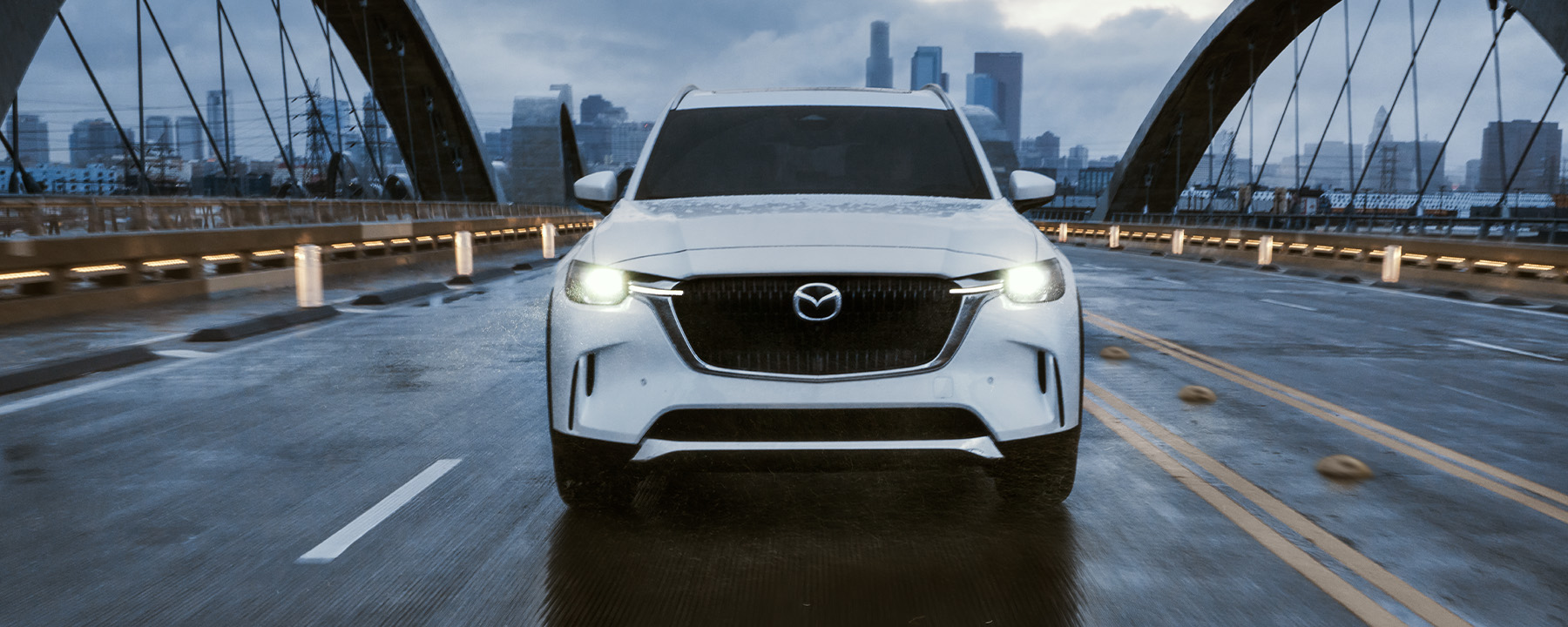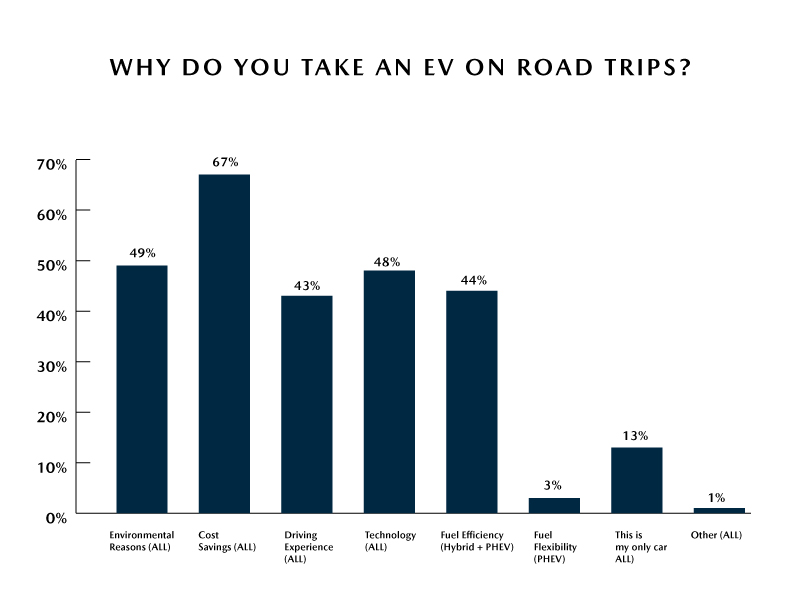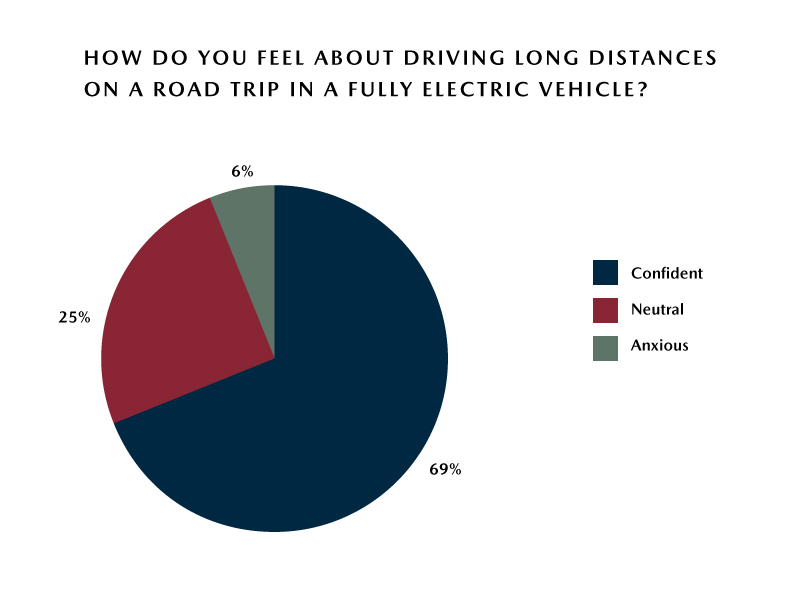EV Road Trip Guide

Key takeaways:
- With longer BEV ranges (and alternatives like PHEVs) on the market, taking a road trip in an EV is more practical and feasible than ever before.
- An increasing number of charging stations have been installed across the country — including near popular road trip destinations like national parks — making it easier and more appealing for EV drivers to plan cross-country trips.
- Most EVs and apps now provide route-planning tools and real-time charging station information to help drivers plan and navigate the needs of their journey.
Many people are switching to electric vehicles (EVs) for the environmental benefits, their zippy feel, and their quiet, powerful performance. One of the biggest deterrents to prospective EV buyers, however, is the fear that EVs can’t “go the distance” on longer journeys… and for that reason, their acquisition would be the demise of one of the mainstays of the American vacation: the road trip.
Our recent survey of North American’s road trip preferences revealed that 93% of Americans enjoy taking road trips and, despite the above fears, 23% already have plans to or already have taken a road trip in an electric, hybrid, or plug-in hybrid vehicle in 2024.
While road trips to remote destinations can be difficult for EV drivers, EV technology and the EV-charging landscape have grown (and continue to grow) more robust, making it perfectly feasible that the background noise of your next road trip will be the telltale whir of an EV motor instead of the classic thrum of an internal combustion engine (ICE).
Here’s what you need to know about hitting the road in an EV, from managing range anxiety to successfully planning your next getaway.

Why Americans Take EVs on Road Trips
The most common reason why EV drivers take their vehicles on road trips is cost savings when it comes to fuel (67%). The other top reasons include environmental reasons (49%), technology (48%), the fuel efficiency of hybrids and PHEVs (44%), and the driving experience (43%). These factors collectively highlight the growing appeal of EVs for long-distance travel, combining economic benefits with environmental responsibility and the enjoyment of innovative automotive technologies.

A quick note on road trips and range anxiety
If you’ve started researching taking a road trip in an EV, you’re bound to run across the term range anxiety. Range anxiety stems from the fear that an electric vehicle’s range won’t be sufficient to see them to their destination — that a car’s battery will drain before a journey’s end. This may be changing however, as only 6% of our survey respondents who have plans to take a full EV on a road trip this summer reported feeling anxious about driving their vehicle long distances while 69% reported feeling confident.
While this concern can arise in any driving scenario (including those in which a gas-powered vehicle is involved) it is especially pertinent to long-distance road trips in an electric vehicle. So much so that it deters prospective buyers from choosing an EV as their mode of transportation in general. But, as noted, with a little bit of planning and an awareness of your vehicle's battery levels, you can certainly avoid being stranded when taking your EV on a road trip.
How far can electric cars go?
Modern battery-electric vehicles (BEVs) typically range from 100-500+ miles on a full charge, while plug-in hybrid electric vehicles (PHEVs) have an electric range of roughly 15-60 miles before automatically switching to their ICE. The true range of a particular EV will depend on how fully it's been charged, the battery’s health, your driving habits, and driving conditions (weather, terrain, etc.).
Your EV trip planning guide
1. Plan your route
Having a good plan in place is crucial to any road trip’s success — even if the plan is “going where the road takes you,” so we’re going to spend a little time discussing this in full. Whether you’re driving an EV or a gas-powered vehicle, the road will eventually need to take you somewhere where you can fill up or juice up. Since EV charging stations are still fewer and farther between than traditional gas stations, you’ll need to be conscientious of your route and make a plan, even if it’s last minute. In fact, 52% of survey respondents plan their route around their favorite charging stations, while 40% simply select the quickest route and charge at any network along the way.
-
Mobile applications can help you find charging stations for your EV — before and during your road trip. They often provide detailed information about charging stations, including real-time availability, pricing, and reviews from other users. Having this data on the go is especially useful when plans change and you need an alternative route.
-
Fast-charging stations are more commonly found along major routes, which can help you charge your EV quickly and get back on the road. The more traffic an area receives, the greater the demand for varied fuel options, and the more likely you will be to find a charging station.
-
If you're planning an EV road trip that spans several days, look for lodging options that have charging stations available. Many hotels and rentals now offer EV charging as an amenity. By choosing a lodging option with a charging station, you can fill up your battery overnight while you sleep, ensuring you start each day with a full charge. At some properties with paid garage parking, drivers may get a discount on that fee.
New to EV Charging? Read our article: How to Charge an EV for helpful tips for charging at home and public charging stations.
-
RV parks might not have dedicated EV charging stations, but many have 240-volt outlets (similar to Level 2 charging outlets). Just keep in mind that for Level 2 charging, you'll need to bring your own portable charger and cable, as RV parks typically only provide the electrical outlet. You may need to arrange this accommodation in advance. Barring the availability of Level 2 charging, you may be able to use a 120-volt outlet for Level 1 charging in a pinch.
-
All road trips come with some speed bumps. Having a backup plan (or several) will help you overcome these hurdles without sacrificing your itinerary. For planning an EV road trip, this might look like:
- Taking a slightly longer route that passes by additional charging locations in case one is unavailable.
- Carrying a portable Level 2 charger, which can add 10-20 miles of range per hour of charging and can be used at any standard 240-volt/50A outlet (look for a NEMA 14-50 outlet).
- Subscribing to a roadside assistance service (a good idea no matter your vehicle’s drivetrain). Many roadside assistance companies now offer emergency mobile EV charging or, at the very least, can tow you to the closest charging station.

2. Incorporate daytime charging time into your plan
Depending on your vehicle’s battery capacity, charging rate, and the EV charging levels available to you, you might be at the charging location for a chunk of time. It’s a good idea to look for charging stations near amenities and activities you can do to pass the time, which brings us to…
3. Combine day charging with activities
Many charging stations are located near shopping centers, restaurants, and other recreational areas, providing drivers with convenient activities to enjoy while their vehicle charges. Factoring in these amenities in your vacation plans can help make EV charging less of a hassle, give you a chance to stretch your legs and, even give you opportunities to have experiences you otherwise would have missed.
4. When planning the next leg of your journey, use conservative estimates of your vehicle’s range
It's generally recommended to be more conservative than the vehicle's estimated range (as seen on your instruments or in an app), and even more cautious if the ambient temperature drops. This is particularly important when the battery is full, as estimates can be less accurate in these situations. In general, it’s best not to plan a down-to-the-wire stop, same as it's unwise to let the needle on your fuel gauge fall to E.
5. Consider signing up for a few charging networks in advance of your trip
Signing up for one or more common charging networks can make accessing and paying for charging stations while on the road less of a hassle. Many of these networks offer apps or membership programs that provide access to their charging stations, streamlined payment options, and benefits like discounted charging rates and exclusive promotions or rewards programs. According to our survey, the largest proportion of Americans who drive either a full EV or PHEV and who are planning to take their vehicle on a road trip this summer prefer to use the Tesla Supercharge Network (37%).
6. Drive to maximize range
There are several strategies that can be employed to maximize range while driving an EV. One is to minimize the use of amenities like air conditioning and heating, as these can consume a lot of power — but that’s not always feasible. Another is to drive conservatively, avoiding sudden acceleration and maintaining a steady speed. Most EVs have some form of regenerative braking that you can use to help you slow down, recharge the battery, and extend your vehicle's range.
7. Keep temperature and terrain in mind
Cold weather and extreme heat alike can cause your battery to become less efficient. Similarly, hilly terrain can be more taxing on an EV's battery, as more energy is required to climb hills. Understanding — and keeping an eye — on the impact these factors can have on your range will help you plan your route and charging stops more effectively for a smooth journey.
8. Know that remote areas still might have few or no charging points
While BEVs offer many benefits, there may be better options if few charging points are nearby. In such cases, PHEVs or even traditional ICE vehicles may be a more practical alternative. As mentioned, PHEVs like the Mazda CX-90 PHEV can operate using both electricity and gasoline, providing the flexibility to switch between power sources as needed.
Road trip with confidence in a Mazda EV
With a little planning and flexibility, taking an EV or a PHEV on a road trip can be both practical and fun. The Mazda CX-90 PHEV and CX-70 PHEV, and the CX-50 Hybrid are designed with sustainability and convenience in mind. Bring the whole family along for the ride, no matter where your next adventure takes you.
Explore the various ways you can make these vehicles yours online or find a Mazda Dealer near you to take a test-drive today.
This article is intended for general informational purposes only and is based on the latest competitive information available at the time of posting. Information herein is subject to change without notice and without Mazda incurring any obligations. Please review a variety of resources prior to making a purchasing decision. Visit Resource Center for more articles.





















